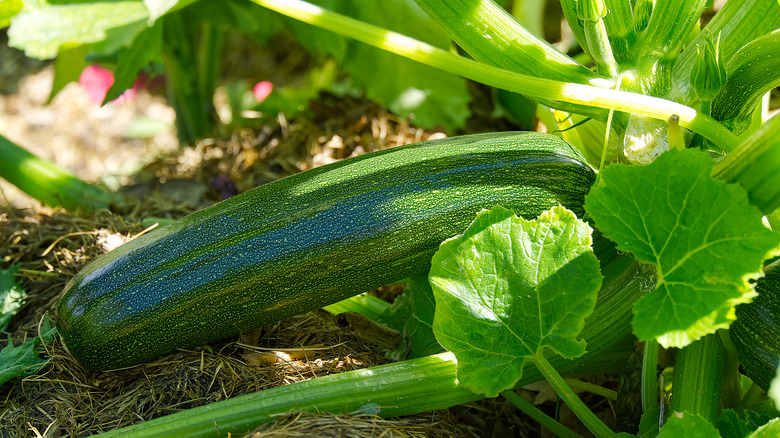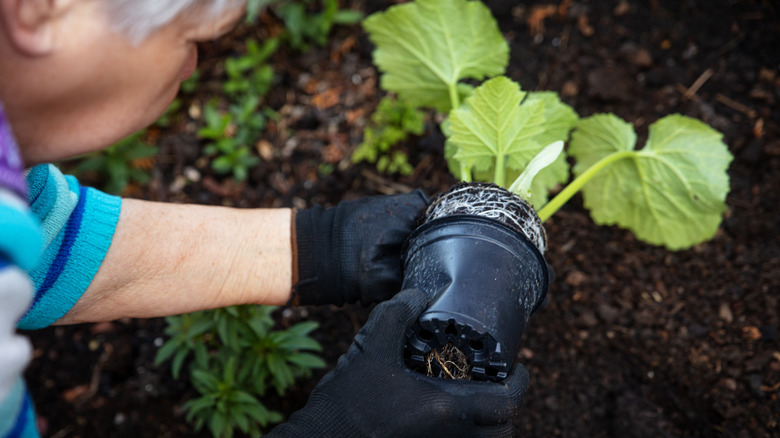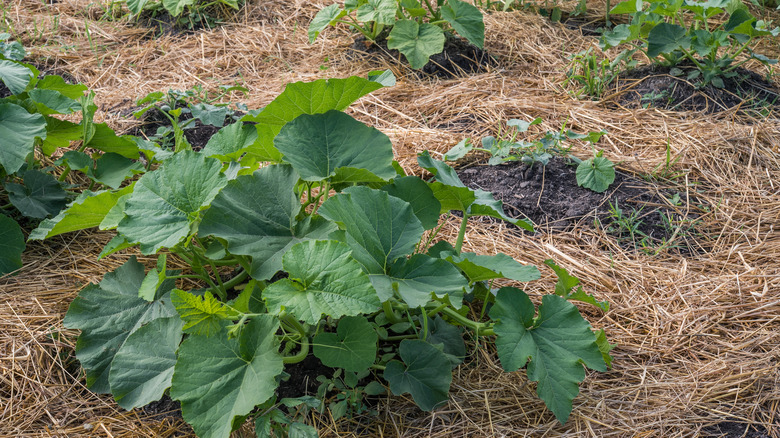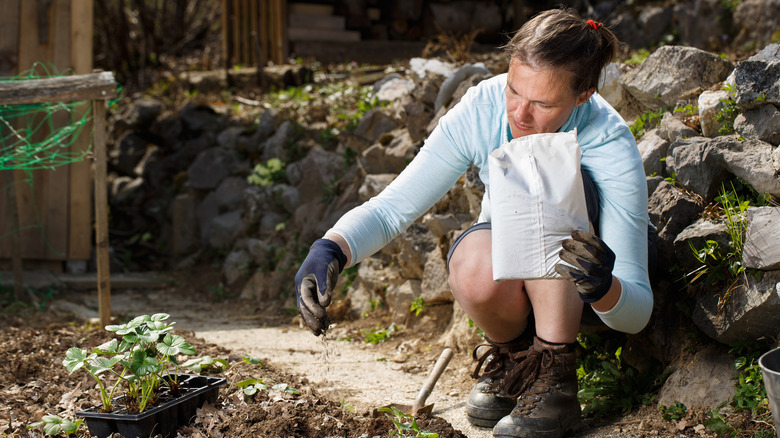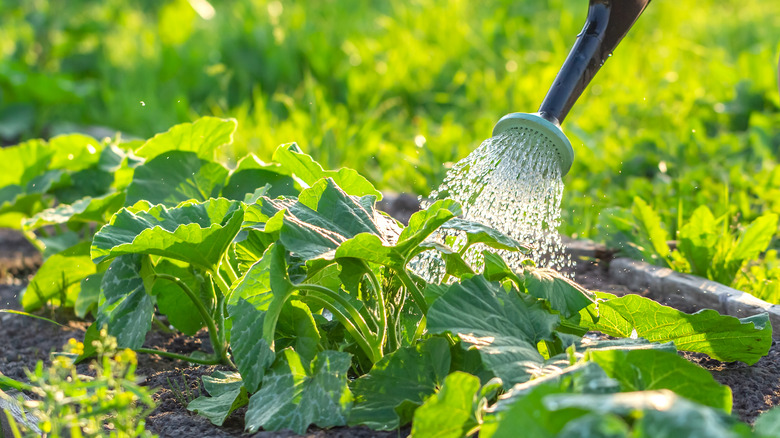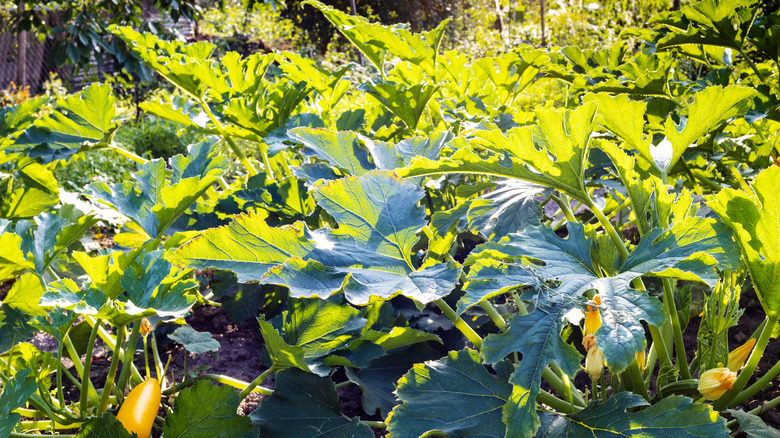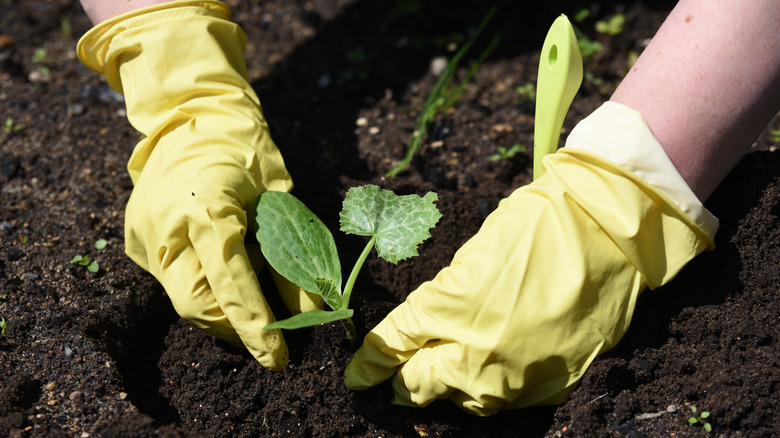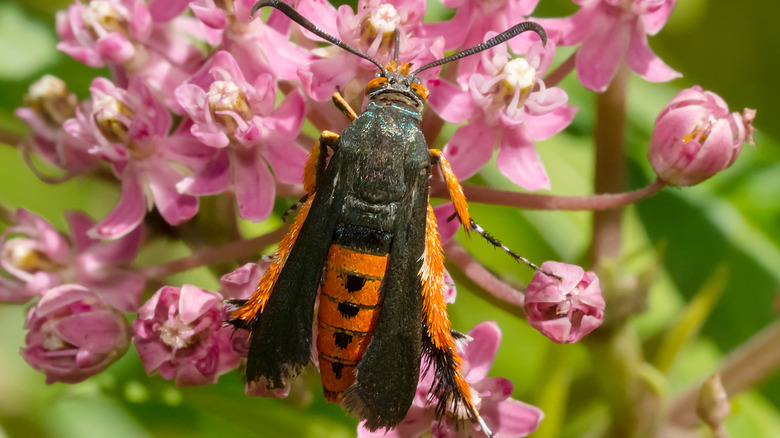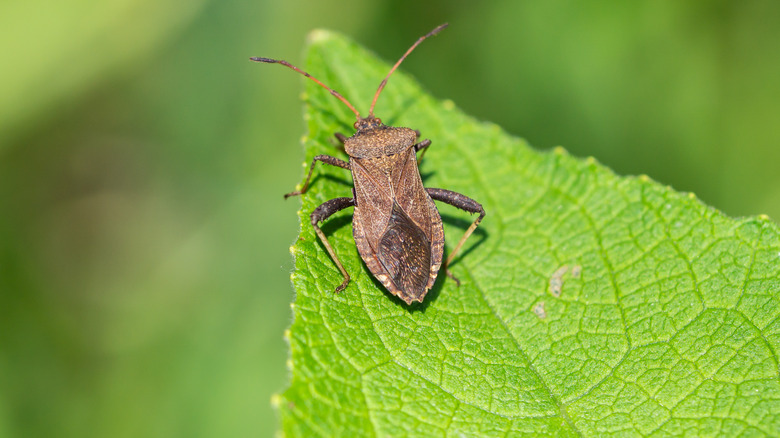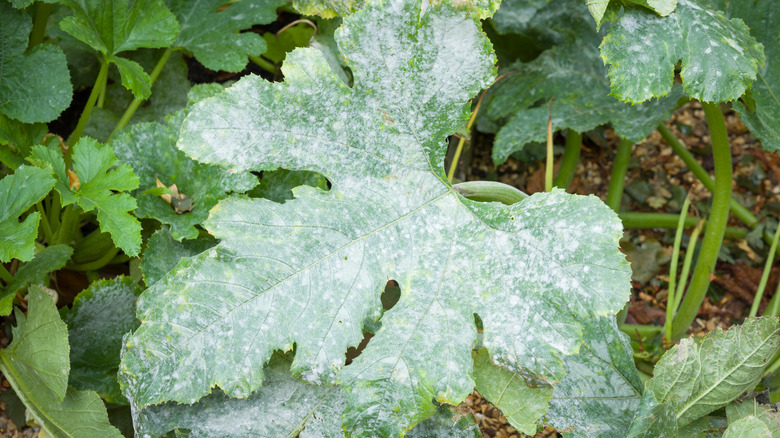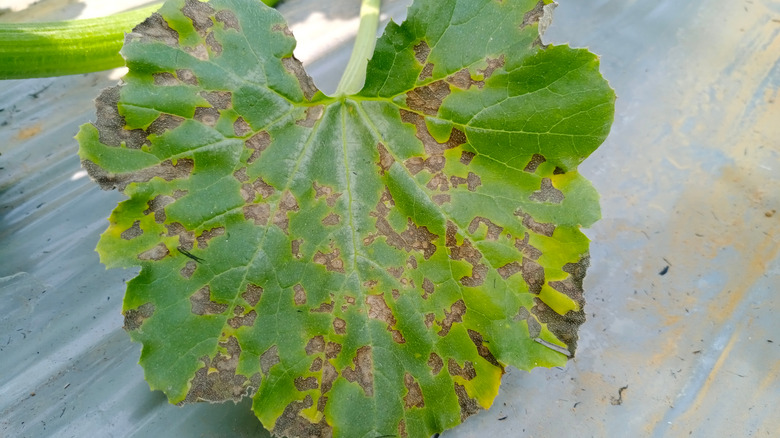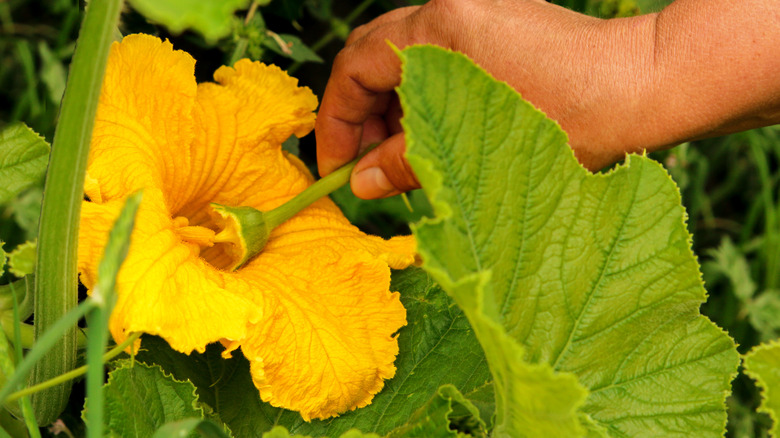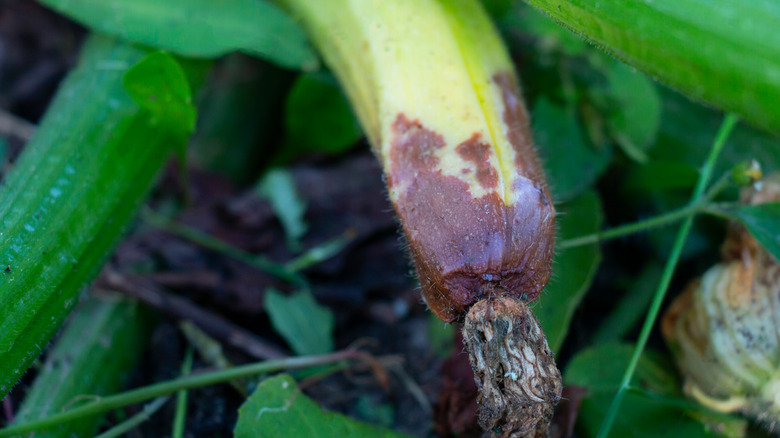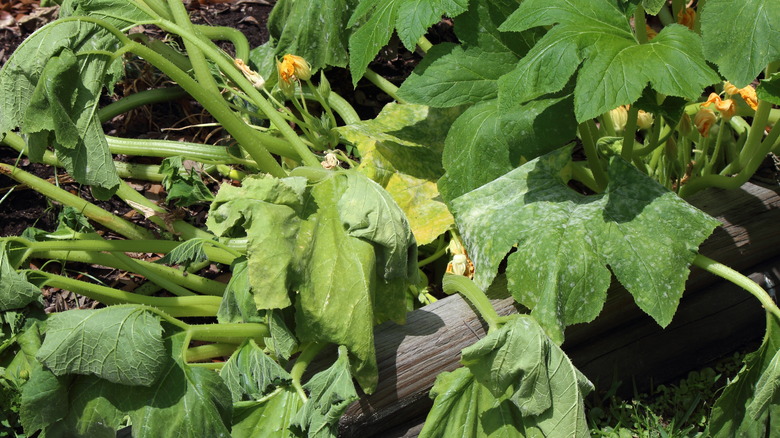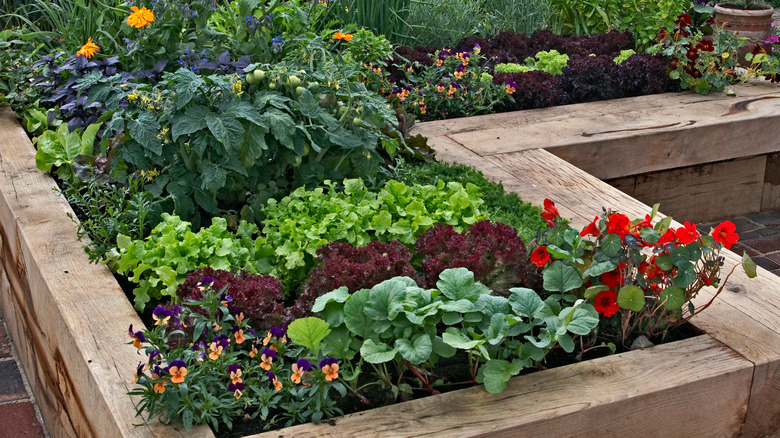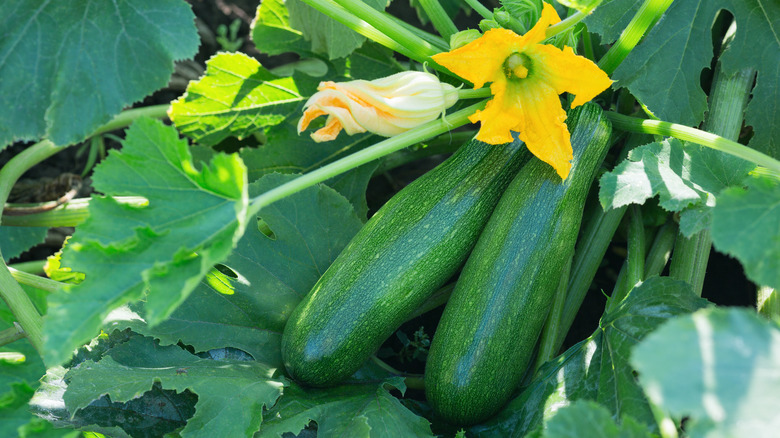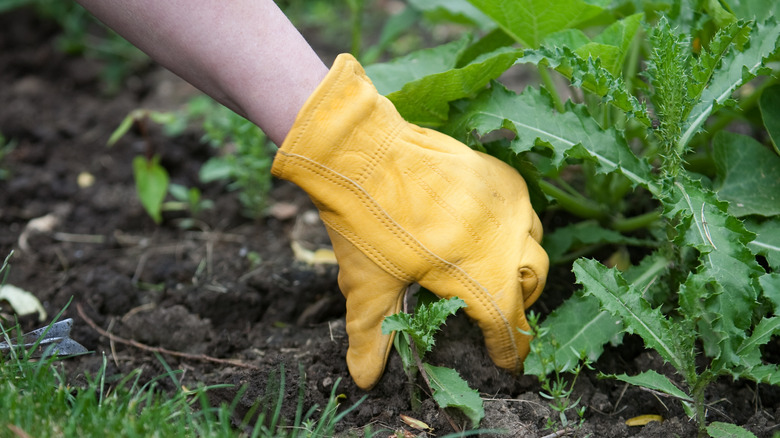17 Easy Tips For Growing Zucchini Plants
Zuchinni (Cucurbitaceae), otherwise known as summer squash, is known to be one of the easiest plants to grow in your garden. While it is classified as a fruit, most people tend to think of it as a vegetable, according to Healthline. Whatever you call it, zucchini is also healthy, so you should include it in your garden. It is rich in several nutrients, including vitamin A, vitamin C, manganese, magnesium, potassium, copper, and phosphorous. Zucchini is naturally low in calories, fat, and sugar, and you can use it to make all kinds of dishes ranging from noodles to bread.
While growing zucchini can be relatively simple, that does not mean that you won't encounter some trouble. From pests to nutritional deficiencies, there are several situations that might hinder or completely halt zucchini growth. No worries, though — we are here to help. We have researched and compiled 17 easy tips to help you keep your zucchini plants thriving throughout the growing season.
1. Plant zucchini at the right time of year
First thing's first: Zucchinis might require less effort than other vegetables, but one thing that will stunt their growth is cold temperatures. You might think planting them early in the season is a good way to get a head start, but this can backfire.
Cold air can damage tender, young leaves, so it is best to wait until there is absolutely no chance of frost. Ideally, the best time to plant zucchini is when night temperatures are at or above 60 degrees, as noted by The Spruce.
2. Plant on a mound of soil
Zucchini plants do better when you plant one or several in a mound rather than in a row, explains The Spruce. Mounds also offer better drainage and allow for better pollination, which is absolutely necessary.
The dirt in mounds also warms quicker, which is important early in the season when the ground in your garden can still be chilly. You can also add compost to mounds, which adds more nutrients to the soil and boosts growth.
3. Fertilize zucchini plants
Speaking of nutrients, zucchini plants need plenty of them. Gardening Guides recommends using a fertilizer that has levels of nitrogen, phosphorus, potassium in either 8-8-8 or 10-10-10 mixtures.
Additionally, fertilize the soil before you plant seeds by applying half of the recommended amount prior to tilling the soil and the remainder after tilling. As the plants grow, follow manufacturer recommendations and apply fertilizer 4 inches to 6 inches on both sides of the roots.
4. Keep zucchini plants hydrated
Zucchini plants are 95% water, so they need plenty of it. If the top of the soil feels dried out, give your plants at least 1 inch to 2 inches of water to keep things moist, suggests SF Gate.
You should water once a week during mild temperatures, and water two to three times a week when it gets hot. SF Gate also explains that you should water near the roots of the plant and avoid getting the leaves wet, since that can lead to powdery mildew or other fungal conditions.
5. Make sure zucchini plants get enough sun
Zucchini plants like things warm, which means they tend to grow best in a garden that receives plenty of sunlight. Louisiana State University recommends planting zucchini in an area that receives six to eight hours of sunlight per day.
Gardening Guides notes that zucchini plants can actually thrive in up to 10 hours of sun each day. Keep in mind, however, that while zucchini plants can grow in shaded areas, they might not produce as much fruit.
6. Plant zucchini in cycles
Because zucchini plants grow fairly quickly, a good way to ensure you have plenty of fruit for the longest amount of time is to grow your plants in cycles or successions. The idea is simple: About one month after you plant your first crop, plant another.
If you have the room, plant another crop after that, too! Fine Gardening says that when your first plants begin to slow, you may even find that you have time left to pull them up and sow a new plant before frost arrives.
7. Watch for borers
Squash vine borers are moth larvae, and they can destroy a healthy zucchini plant in just a few days. The moths lay eggs on the stem, and the larvae eat their way in, blocking the passage of nutrients throughout the plant. They are difficult to remove once inside the plant and will last until the next summer, so a good defense is key.
The University of Minnesota notes that the moths generally appear in the last weeks of June, so that's the time to start looking for their small, flat, brown eggs on the base of your plant stems. Since squash vine borers are attracted to yellow, you can trap the moths by placing a container of water next to a colored container in the garden — they'll fly towards the yellow object, and ultimately fall into the water. Another option is to spray pesticides at the base of the plants when vines start to run, repeating every 7 to 10 days.
8. Control squash bug population
Vine borers are not the only pest you need to worry about. Squash bugs lay their eggs on the bottom of zucchini leaves, and once they hatch, they can introduce toxins to the plant.
Gently wipe any of these eggs away when you see them. To keep the bug problem under control, look at your leaves about once a week. Bob Vila suggests keeping a container of soapy water nearby, and regularly scraping the bugs off the leaves into the mixture when you see them.
9. Keep an eye out for powdery mildew
Powdery mildew is a white-looking fungus that grows on the leaves of zucchini plants. Once leaves have been infected, the fungus is tough to control, so spraying the plant with a homemade sulfur solution before you spot any mildew helps. The Old Famer's Almanac recommends a mixture of 1 teaspoon of baking soda to 1 quart of water.
You can also try fungicides that include sulfur, lime, and neem oil. When you see the spots on leaves, cut them from the plant and throw them away. Do not compost them because the fungus spores will spread to any nearby foliage and cause more damage. In addition, always clean your gardening tools with alcohol after cutting infected leaves to prevent spores from spreading.
10. Be on the lookout for downy mildew
Downy mildew is another fungus that can appear on zucchini plant leaves. Like powdery mildew, it is generally caused by too much moisture. This disease will appear as small yellow spots that will spread and eventually kill the leaves.
A good way to prevent downy mildew is by keeping zucchini leaves dry, and by using products that contain copper hydroxide or copper sulfate to disinfect the leaves, according to Purdue University. Fungicides are another option to keep downy mildew at bay.
11. Hand-pollinate zucchini plants
Zucchini plants produce female and male flowers, and the female flowers need to be pollinated before they can bear fruit. You'll know a female bloom because it will have a swollen end that looks like a tiny zucchini on the end of it. Sometimes pollinators don't come around when your female blooms are open, and you might have to take matters into your own hands.
Hand-pollinating a female bloom is easy enough: Simply use the end of a cotton swab or small paintbrush to gather pollen from a male bloom and place it in the stigma in a female bloom. Grow Veg also recommends picking the male flower, pulling back the petals to expose the stamen, and rubbing it on the stigma in the female bloom. This should boost growth when the weather is cold or rainy, or when there aren't many zucchinis yielded from the plant.
12. Check for blossom end rot
If you've ever been excited about a small zucchini only to have your hopes dashed when the blossom wilts and results in the fruit dying, you've probably experienced blossom end rot. Gardening Know How warns that this issue is almost always a calcium deficiency in the soil.
You can test your soil to check the levels and add calcium carbonate if it is lacking. A simple way to do this is to insert an antacid tablet in the soil near the base of the zucchini plant. Another option is to use a calcium chloride or calcium nitrate drip system. Blossom end rot can also be caused by too much nitrogen in the soil, so avoid using fertilizers that have nitrogen or ammonia.
13. Recognize bacterial wilt
You'll know your zucchini is affected by bacterial wilt when individual leaves start to look limp despite adequate waterings. The most common cause of the bacteria is cucumber beetles.
To check for this disease, cut the dying leaf from the vine and slice the stem open. If you see sticky threads or something oozing from the stem, your plant most likely has bacterial wilt, according to Iowa State University. While you can use insecticides to control an existing beetle population, row covers can usually help prevent it in the first place.
14. Grow zucchini with compatible plants
Companion plants are helpful in many ways. Because zucchini plants need pollinators, it's always a good idea to have a few surrounding plants to attract them. Flowering plants, such as nasturtium and borage, often do the trick. Nasturtium also keeps aphids out of your garden. Radishes are another great option that tends to keep squash bugs at bay.
There are also plants that you should avoid growing near zucchini, however. Potatoes tend to pull nutrients from the soil, which could affect the growth of your zucchini. Pollinators don't like the smell of rosemary, so keep it out of your garden to help out your zucchini, according to Garden Design.
15. Harvest at the right time
Most zucchini fruit can be harvested in about 45 to 60 days, or when the fruit is about 6 inches to 8 inches long. The Old Farmer's Almanac suggests not letting zucchini grow much longer because the fruits will lose most of their flavor.
In addition, harvesting them from the plant at the two-month mark encourages new growth. Always cut the fruit from the plant to avoid damaging the stem, and leave about 1 inch of the stem on the plant — that way, you'll be geared up to grow even more!
16. Be sure to eliminate weeds
Competition is not just for sports; it happens in the garden, too. Your soil has limited resources, and every plant growing in that area fights for water and nutrients. Naturally, you want your zucchini plants to win the battle, so for that to happen, you have to remove the competition.
Left to grow, weeds and grass can steal vital resources from your plant, leaving it stunted and weak. Weak plants are more susceptible to pests and disease. Keeping the area around your zucchini plants weeded ensures they have the best chance of staying healthy.
17. Don't plant zucchini in the same place every year
Since disease, fungal issues, and pests can overwinter in the soil, crop rotation is a simple way to reduce these problems. This can be challenging in small gardens, but if you have the space, avoid planting zucchini in the same place for three years.
For example, if you grow zucchini in the northeast corner of your garden this year, plant it in the southwest corner next year, then the northwest corner the following year. If you can rotate these plants around your garden yearly, your squash bugs may be unable to keep up with the moves.
